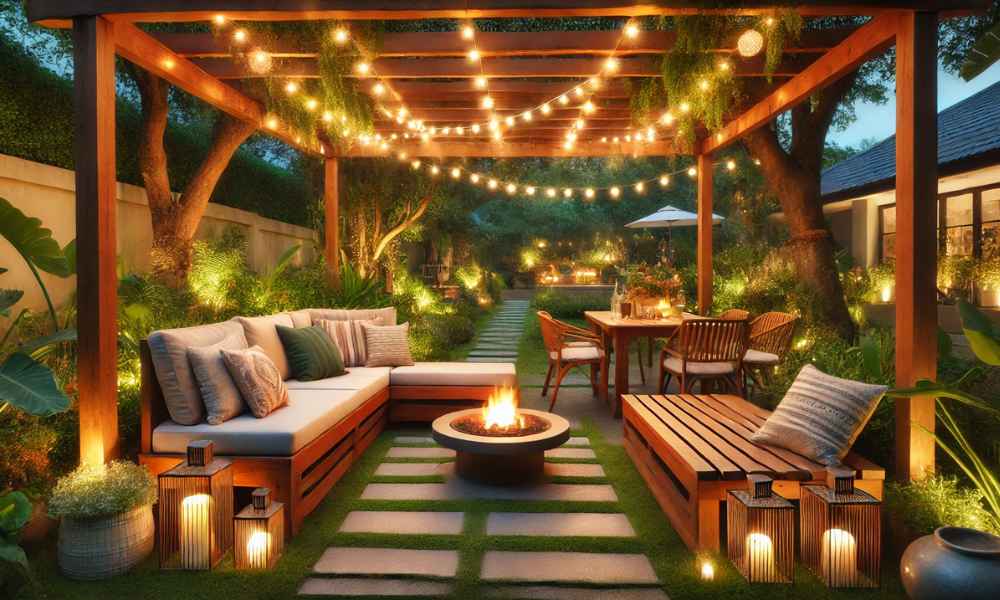How To Build Outdoor Seating Area transforms a backyard, patio, or garden into a welcoming space for relaxation, entertainment, and connection with nature. Whether you’re looking for a quiet corner to sip your morning coffee or a spacious area to host family gatherings, designing the perfect seating arrangement requires careful planning. From choosing the right spot to selecting durable materials and enhancing comfort, every detail matters. This guide will walk you through the process of creating an inviting outdoor seating area, ensuring that it meets both aesthetic and functional needs.
Choosing the Perfect Spot for Your Outdoor Seating Area
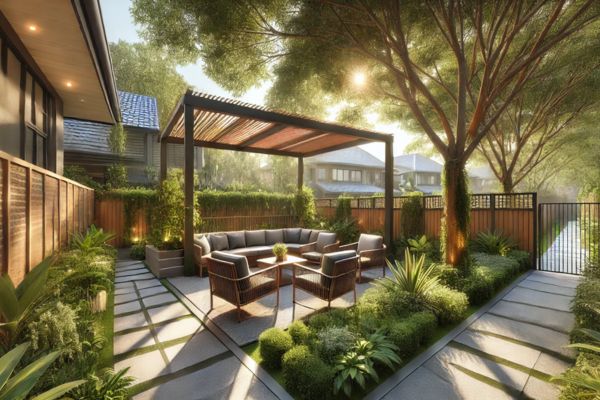
Location is everything when it comes to crafting a comfortable and practical outdoor seating space. Before committing to a specific spot, consider these essential factors:
- Sunlight and Shade: Observe how the sun moves across your yard throughout the day. If you enjoy soaking up the sun, opt for an area with ample exposure. For a cooler retreat, choose a shaded nook under trees or near a pergola.
- Wind Patterns: Strong gusts can turn a cozy outdoor setup into a chaotic scene. Identify wind directions to strategically position seating against walls, hedges, or natural windbreaks.
- Privacy Matters: A well-placed seating area should offer a sense of seclusion. Use fences, trellises, or tall plants to shield the space from neighbors’ views while maintaining an open and airy feel.
- Proximity to the House: If you plan to use the seating area for dining or entertaining, keeping it close to the kitchen or living area ensures easy access.
Designing Your Outdoor Seating Area Layout
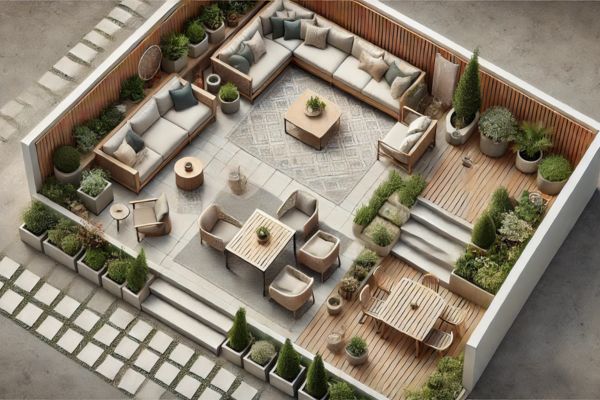
Once the location is chosen, it’s time to design a layout that maximizes both beauty and function.
- Define the Purpose: Do you want a cozy reading nook, a dining space, or a lounge for socializing? Identifying the primary use will influence the size, furniture, and features you incorporate.
- Zoning the Space: If your outdoor area is large, consider dividing it into multiple zones—one for dining, another for lounging, and a separate space for kids or pets. Use rugs, planters, or pathway stones to create visual divisions.
- Balancing Open Space: Avoid overcrowding. Leave enough room for movement while ensuring the area feels intimate and inviting.
Selecting the Right Seating for Your Outdoor Space
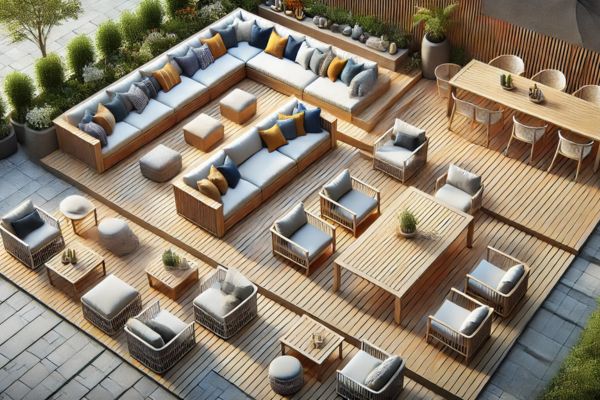
Comfort and durability should be top priorities when choosing outdoor seating.
- Built-in vs. Movable Seating: Built-in benches provide a permanent and cohesive look, while movable chairs and sofas offer flexibility to rearrange the space as needed.
- Materials Matter: Choose weather-resistant materials such as teak, powder-coated metal, or all-weather wicker to ensure longevity. Avoid fabrics that fade easily under the sun or become damaged by rain.
- Cushions and Upholstery: Opt for outdoor-rated cushions that resist moisture, mold, and UV exposure. Consider removable covers for easy cleaning.
Adding Shade and Protection for All-Weather Use
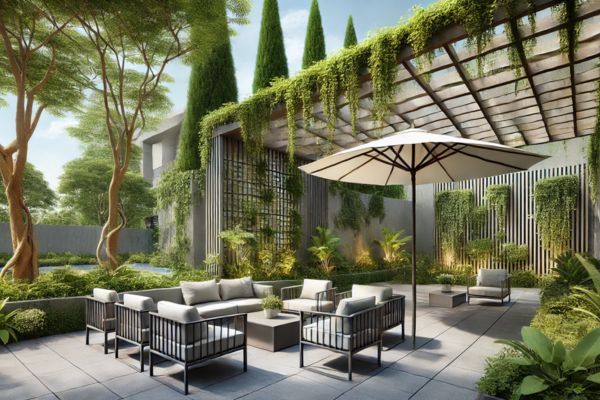
To make your seating area enjoyable year-round, incorporate elements that shield it from the elements.
- Pergolas and Gazebos: A pergola with climbing vines or a retractable shade cover adds a touch of elegance while providing relief from the sun.
- Umbrellas and Awnings: For a budget-friendly option, a large patio umbrella or retractable awning offers adjustable shade.
- Natural Shade: Trees, tall shrubs, or a living wall covered in ivy create a cooling effect while enhancing the natural beauty of the space.
Flooring and Foundation: Setting Up a Stable Base
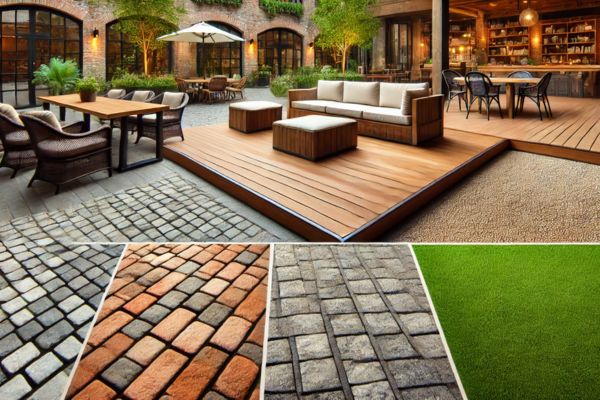
The foundation of your outdoor seating area should be both functional and visually appealing.
- Paving Stones and Brick: These options add durability and a classic touch while preventing chairs from sinking into the ground.
- Decking: A wooden or composite deck creates a warm and polished look, blending seamlessly with natural surroundings.
- Gravel or Pea Stones: For a casual and low-maintenance solution, a gravel base provides excellent drainage and a rustic aesthetic.
- Artificial Grass or Turf: If you want a soft, green surface without the upkeep of real grass, artificial turf offers an inviting alternative.
Creating a Cozy Ambiance with Lighting
Lighting plays a crucial role in setting the mood for your outdoor seating area, enhancing both aesthetics and functionality. Soft, warm lighting creates an inviting atmosphere, while task lighting ensures visibility for evening activities. String lights draped across a pergola or woven through trees offer a magical glow, instantly making the space feel more intimate. Solar-powered lanterns provide an eco-friendly solution, adding charm without increasing energy costs. For a modern touch, LED strip lights installed under seating or along pathways create a sleek and stylish ambiance. To ensure safety, strategically place pathway lights or motion-sensor fixtures to illuminate walkways and stairs. A well-lit outdoor seating area allows you to enjoy your space long after the sun has set, creating a cozy retreat for relaxation and social gatherings.
Adding Greenery and Natural Elements
Incorporating greenery into your outdoor seating area not only enhances its visual appeal but also contributes to a serene and refreshing atmosphere. Potted plants, hanging baskets, and vertical gardens bring life to the space, adding layers of color and texture. Native plants or low-maintenance succulents require minimal care while thriving in outdoor conditions. Consider adding a living wall covered in ivy or flowering vines to create a natural backdrop that provides both beauty and privacy. For a more immersive experience, small trees, bamboo screens, or a hedge of ornamental grasses can define the space while offering a touch of tranquility. Water features, such as a small fountain or pond, introduce soothing sounds that promote relaxation. By incorporating natural elements, your outdoor seating area becomes a peaceful escape that seamlessly blends with its surroundings.
Enhancing Comfort with Accessories and Decor
Comfort is key when designing an outdoor seating area that encourages relaxation and socialization. Weather-resistant cushions and throw blankets add softness and warmth, making seating areas more inviting. Outdoor rugs help define the space while adding color and texture, creating a homely feel. To personalize the area, incorporate decorative elements such as lanterns, ceramic vases, or rustic wooden trays for a charming touch. A fire pit or tabletop fireplace can serve as a focal point, providing warmth on cooler evenings while fostering a cozy, communal atmosphere. Shade solutions, like retractable canopies or oversized umbrellas, ensure comfort during hot, sunny days. Thoughtfully chosen accessories and decor transform a simple outdoor seating arrangement into a luxurious retreat, encouraging you to spend more time outdoors.
Storage Solutions for a Clutter-Free Outdoor Space
Keeping your outdoor seating area organized ensures that it remains a relaxing and functional space. Storage solutions help maintain cleanliness while protecting outdoor essentials from the elements. Multi-functional furniture, such as benches with hidden storage compartments, provides an excellent way to store cushions, blankets, and outdoor accessories without taking up extra space. Waterproof storage boxes or deck cabinets keep grilling tools, garden supplies, and other essentials neatly tucked away. For smaller spaces, vertical storage solutions like wall-mounted shelves or hanging baskets maximize efficiency while keeping necessities within reach. A well-organized outdoor space not only looks more appealing but also makes it easier to enjoy, as everything is readily accessible when needed.
Budgeting and Cost-Effective Tips
Building an outdoor seating area doesn’t have to drain your wallet. With strategic planning and a little creativity, you can create a stylish and functional space on a budget. Start by determining your must-have features and set a realistic spending limit. Upcycling materials, such as repurposing wooden pallets for seating or using reclaimed bricks for flooring, can significantly cut costs while adding a rustic charm to your space. Shopping secondhand for outdoor furniture or waiting for seasonal sales can help you find quality pieces at a fraction of the price. Instead of hiring professionals, consider tackling DIY projects, such as building your own benches or installing a simple pergola. Investing in durable materials from the start prevents costly repairs and replacements down the road. With a little resourcefulness, you can design a stunning outdoor seating area without overspending.
Maintenance and Care for Your Outdoor Seating Area
To keep your outdoor seating area looking fresh and inviting, regular maintenance is essential. Exposure to sun, rain, and changing temperatures can take a toll on outdoor furniture and materials. Start by choosing weather-resistant furniture and treating wooden pieces with a protective sealant to prevent rotting and fading. Cushion covers and fabrics should be UV-resistant and easy to clean—storing them in a waterproof container when not in use will extend their lifespan. Sweep and wash outdoor flooring regularly to remove dirt, leaves, and debris that can cause staining or wear over time. If you have a pergola or awning, check for mold or mildew buildup, especially after rainy seasons. Keeping your seating area well-maintained ensures that it remains a comfortable and beautiful space for years to come.
Common Mistakes to Avoid When Building an Outdoor Seating Area
Many homeowners make avoidable mistakes when designing an outdoor seating space, which can lead to discomfort, high maintenance, or inefficient use of space. One of the biggest mistakes is choosing the wrong location—placing seating in an area with too much direct sunlight or in a spot prone to strong winds can make it less enjoyable. Another common misstep is overcrowding the space with furniture, leaving little room for movement. Instead, balance functionality with open space to ensure comfort and accessibility. Ignoring drainage issues can also create long-term problems—seating areas should be placed on well-drained surfaces to prevent water damage and mold growth. Additionally, many people overlook the importance of shade and weather protection, which can result in an uncomfortable space during extreme weather conditions. Avoiding these mistakes will help you build a seating area that is both practical and enjoyable.
Final Touches
Once the basic structure of your outdoor seating area is complete, adding thoughtful final touches will elevate its charm and functionality. Layering outdoor cushions and throw blankets in complementary colors enhances comfort while giving the space a cozy, inviting look. A well-placed outdoor rug can define the area and add warmth underfoot. Integrating decorative elements such as potted plants, lanterns, and hanging lights will personalize the space and create a relaxing ambiance. If space allows, consider adding a fire pit, water feature, or an outdoor bar to make the area more versatile and enjoyable for different occasions. Small details, such as stylish side tables, candle holders, and wind chimes, contribute to a welcoming atmosphere, making your outdoor seating area a true extension of your home.
